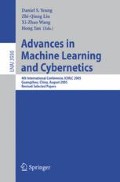Abstract
This paper proposes a novel environmental/economic load dispatch model by considering the fuel cost and emissionfunctions with uncertain co-efficients and the constraints of a ramp rate. The uncertain coefficients are represented by fuzzy numbers, and the model is known as fuzzy dynamic environmental/economic load dispatch (FDEELD) model. A novel weighted ideal point method (WIPM) is developed to solve the FDEELD problem. The FDEELD problem is first converted into a single objective fuzzy nonlinear programming by using the WIPM. A hybrid evolutionary algorithm with quasi-simplex techniques is then used to solve the corresponding single objective optimization problem. A method of disposing constraint and a fuzzy number ranking method are also applied to compare fuzzy weighted objective function values of different points. Experimental results show that FDEELD model is more practical; the algorithm and techniques proposed are efficient to solve FDEELD problems.
Access this chapter
Tax calculation will be finalised at checkout
Purchases are for personal use only
Preview
Unable to display preview. Download preview PDF.
References
Abido, M.A.: Environmental/economic power dispatch using multiobjective evolutionary algorithms. IEEE Transactions on Power Systems 18(4), 1529–1537 (2003)
Venkatesh, P., Gnanadass, R., Padhy, N.P.: Comparison and application of evolutionary programming techniques to combined economic emission dispatch with line flow constraints. IEEE Transactions on Power Systems 18(2), 688–697 (2003)
Rughooputh, H.C.S., Ah King, R.T.F.: Environmental/economic dispatch of thermal units using an elitist multiobjective evolutionary algorithm. In: 2003 IEEE International Conference on Industrial Technology, vol. 1, pp. 48–53 (2003)
Kiyota, T., Tsuji, Y., Kondo, E.: Unsatisfying functions and multiobjective fuzzy satisfaction design using genetic algorithms. IEEE Transactions on Systems, Man and Cybernetics, Part B 33(6), 889–897 (2003)
Wang, K.P., Yuryevich, J.: Evolutionary programming based algorithm for environmentally constrained economic dispatch. IEEE Transactions on Power Systems 13(2), 301–306 (1998)
Huang, C.-M., Yang, H.-T., Huang, C.-L.: Bi-objective power dispatch using fuzzy satisfaction-maximizing decision approach. IEEE Transactions on Power Systems 12(4), 1715–1721 (1997)
Watts, D., Atienza, P., Rudnick, H.: Application of the Power Exchange-Independent System Operator Model in Chile. In: Power Engineering Society Summer Meeting, 2002 IEEE, vol. 3, pp. 1392–1396 (2002)
Wen, F., David, A.K.: Coordination of bidding strategies in day-ahead energy and spinning reserve markets. International Journal of Electrical Power & Energy Systems 24(4), 251–261 (2002)
Albuyeh, F., Alaywan, Z.: California ISO formation and implementation. IEEE Computer Applications in Power 12(4), 30–34 (1999)
Nelder, J.A., Mead, R.: A simplex method for function minimization. The Computer Journal 5 (1965)
Zhang, G., Wu, Y.-H., Remias, M., Lu, J.: Formulation of fuzzy linear programming problems as four-objective constrained optimization problems. Applied Mathematics and Computation 139(2-3), 383–399 (2003)
Lee, E.S., Li, R.L.: Comparison of fuzzy numbers based on the probability measure of fuzzy events. Comput. Math. Appl. 15, 887–896 (1988)
Cheng, C.-H.: A new approach for ranking fuzzy numbers by distance method. Fuzzy Sets and Systems 95(3), 307–317 (1998)
Tran, L., Duckstein, L.: Comparison of fuzzy numbers using a fuzzy distance measure. Fuzzy Sets and Systems 130(3), 331–341 (2002)
Author information
Authors and Affiliations
Editor information
Editors and Affiliations
Rights and permissions
Copyright information
© 2006 Springer-Verlag Berlin Heidelberg
About this paper
Cite this paper
Zhang, Gl., Li, Gy., Xie, H., Ma, Jw. (2006). Application of Weighted Ideal Point Method to Environmental/Economic Load Dispatch. In: Yeung, D.S., Liu, ZQ., Wang, XZ., Yan, H. (eds) Advances in Machine Learning and Cybernetics. Lecture Notes in Computer Science(), vol 3930. Springer, Berlin, Heidelberg. https://doi.org/10.1007/11739685_46
Download citation
DOI: https://doi.org/10.1007/11739685_46
Publisher Name: Springer, Berlin, Heidelberg
Print ISBN: 978-3-540-33584-9
Online ISBN: 978-3-540-33585-6
eBook Packages: Computer ScienceComputer Science (R0)

